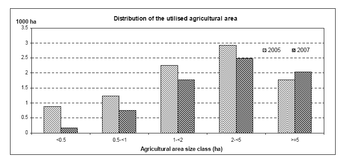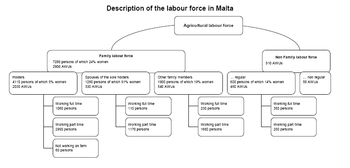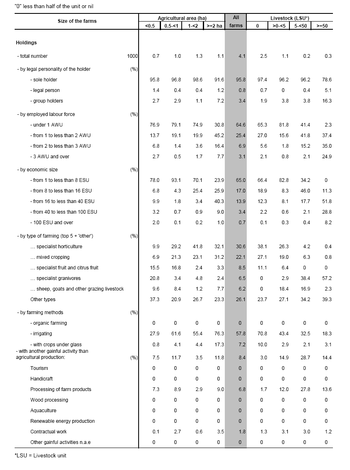Archive:Farm structure in Malta - 2007 results
- Data from July 2008. Most recent data: Further Eurostat information, Main tables and Database.
This article is part of a series of country-specific essays on the results of the European Union (EU) Farm structure survey (FSS) 2007. It provides a brief but nevertheless comprehensive insight into farm structure in Malta.
11 020 agricultural holdings were recorded in Malta in the 2007 Farm structure survey (55 less than in 2005). Only 38 % of these holdings had an economic size of at least one European size unit (ESU), compared to about 74 % in 2005. This big difference is due to a change in agricultural prices, which has reduced the total standard gross margins (SGM) over recent years.
Main statistical findings
Increase in the number of horticultural holdings: 39 % from 2005 to 2007
In 2007, about 4 100 agricultural holdings in Malta had an economic size of at least one European size unit.
These farms made use of 7 200 hectares (ha) of utilised agricultural area (UAA), which makes the average size of a holding in Malta 1.75 ha (compared to 1.11 ha in 2005). See Figure 1 for the distribution of UAA in terms of farm size, while Table 2 describes the size distribution and other characteristics of the agricultural holdings.
These holdings employed 3 400 annual work units (AWU), the equivalent of 3 400 people working full time. The organization and distribution of the labour force in Malta is described in Figure 2 and Table 1.
The farms contained 49 000 livestock units (LSU) in 2007, 7 % more than in 2005. The distribution of livestock by farm size is shown in Table 4 and Figure 3.
Amongst the 4 100 agricultural holdings in 2007:
- 65 % made use of less than one AWU, while another 10 % made use of two or more AWUs;
- 42 % used less than 1 ha, while 27 % used 2 ha or more;
- 11 % of the holdings were producing mainly for own consumption;
- 31 % were specialists in horticulture and 22 % were holdings of the type mixed cropping;
- 16 % were specialists in livestock;
- 3 % were mixed farms.
Amongst the sole holders:
- 5 % were women in 2007 (compared to 7 % in 2005);
- 50 % were aged 55 or more and 6 % were younger than 35 years;
- 50 % of sole/main holders had another gainful activity in 2007.
In Malta in 2007, 18 % of the agricultural area was farmed by the owner.
The labour force has decreased by 12 % from 2005 to 2007.
39 % of the UAA was irrigated in 2007. The area of irrigated land has increased by 14 % from 2005 to 2007. This increase is mainly related to the large number of horticultural holdings (39 % more than in 2005). Details of land use by size of farm are given in Table 3.
There was an increase of 11 % in the number of goats, but a reduction of 23 % in the number of sheep.
The situation for subsistence farming in Malta is outlined in Table 5.
Data sources and availability
Due to the different coverage of the FSS across Member States, the total number of farms is not comparable between countries. This is why the present analysis, including Tables 1-4 and the graphs focus on holdings of at least one European size unit.
The survey on the structure of agricultural holdings was carried out in Malta in the autumn of 2007 on a sample basis. The previous full-scale agricultural census was conducted in 2001, and the last sample farm structure survey was in 2005. The reference period for the FSS 2007 was the crop year 2006/07 (ending on 31 August 2007), for livestock the 1st of September 2007 and the period for labour force referred to the 12 months preceding the day of the survey.
The target population were the holdings, according to the national definition, whose area consists of land and/or buildings on which agricultural activities are carried out. No thresholds were used, and the initial population was composed of all the holdings included in the statistical farm register, which is updated continuously on a regular basis.
The population was stratified according to the type of farming (8 groups) and economic size (3 groups), as well as the regions. Certain typology and size classes were clustered in order to get a representative sample. All the holdings having at least 8 ESU were sampled surveyed exhaustively. In the other strata the optimum allocation method was used with random selection. Holdings in each sampled strata were chosen on the proportion of the total standard deviation of the SGM within the strata. Altogether 1332 holdings have been selected, which is 12 % of the registered population.
The list of characteristics and their definitions were fully compliant with the EU requirements concerning the Farm Structure Survey 2007. However some characteristics were not surveyed due to their non-existence or insignificance in the country's agricultural structure, in accordance with Regulation 204/2006.
The data are checked at different levels. A first check is done at the collection stage, where the consistency checks of the totals are carried out by the interviewer. The next quality control was a manual verification of the completeness of the surveys; farmers were then contacted by phone when clarification was needed. The data were also checked during the input phase using a specific application.
For each activity (`enterprise`) on a farm (for instance wheat, dairy cow or vineyard), a standard gross margin (SGM) is estimated, based on the area (or the number of heads) and a regional coefficient. The sum of such margins in a farm is its economic size, expressed in European size units (ESU, 1 ESU is a 1200-euro standard gross margin).
Each farm is classified in the community typology by its economic size and its type of farming, depending on the share of each enterprise in its economic size.
Annual work unit (AWU) is equivalent to a worker employed on a full time basis for one year. In Malta it is 1800 hours (225 working days of 8 working hours per day).
Context
European Commission rural development policy aims to improve competitiveness in agriculture and forestry, improve the environment and countryside, improve the quality of life in rural areas and encourage the diversification of rural economies.
As agriculture has modernised and the importance of industry and services within the economy has increased, so agriculture has become much less important as a source of jobs. Consequently, increasing emphasis is placed on the role farmers can play in rural development, including forestry, biodiversity, the diversification of the rural economy to create alternative jobs and environmental protection in rural areas.
The FSS continues to adapt to provide timely and relevant data to help analyse and follow these developments.
See also
Further Eurostat information
Publications
- Farm Structure Survey in Malta - 2007 - Statistics in focus 73/2008
- National Methodological Report – FSS 2007 Malta (available on request)
Main tables
- Agriculture, see:
- Farm structure: historical data (1990-2007) (t_ef)
Database
- Agriculture, see:
- Farm Structure (ef)
Dedicated section
- Ad-hoc tables: Farm Structure Survey
Methodology / Metadata
- Farm Structure (ESMS metadata file — ef_esms)







